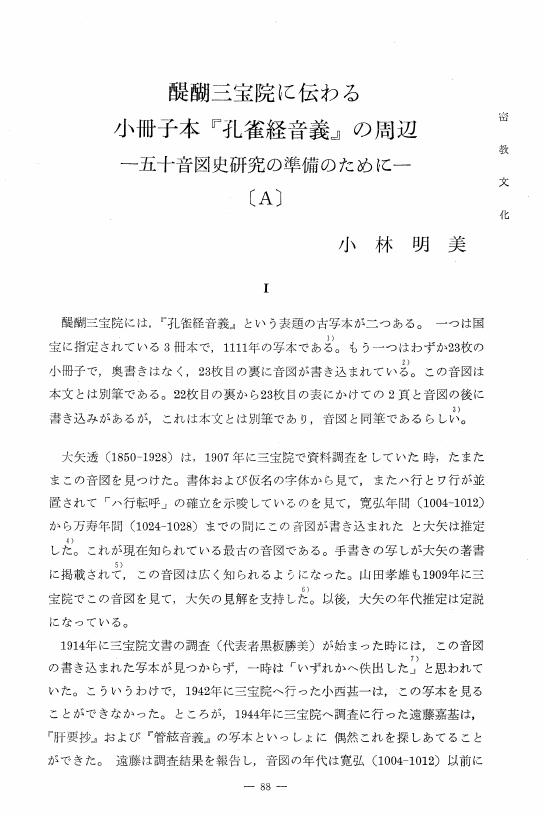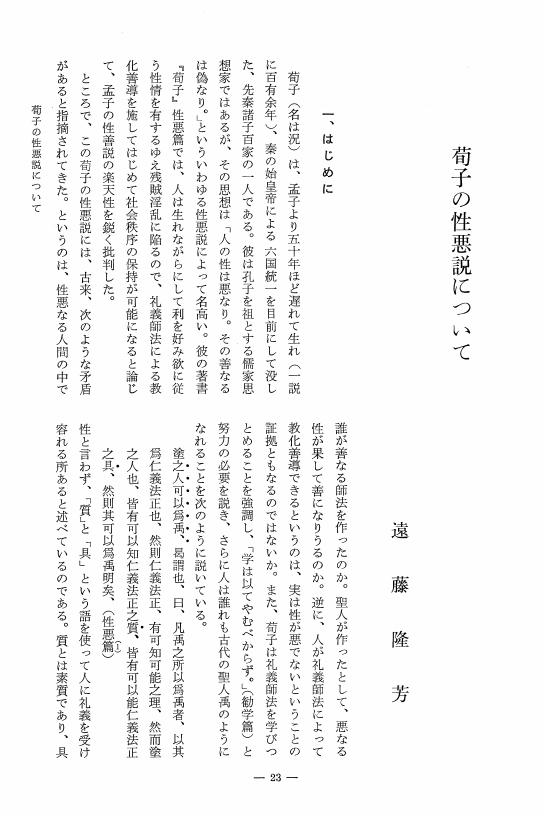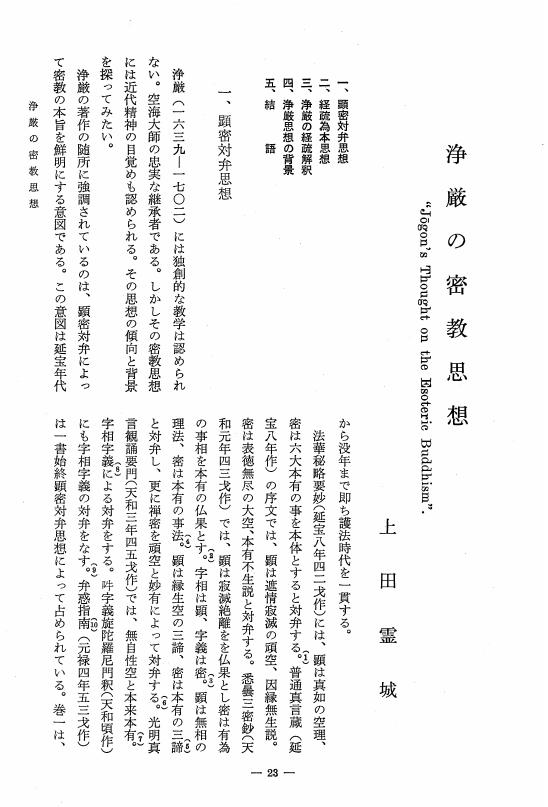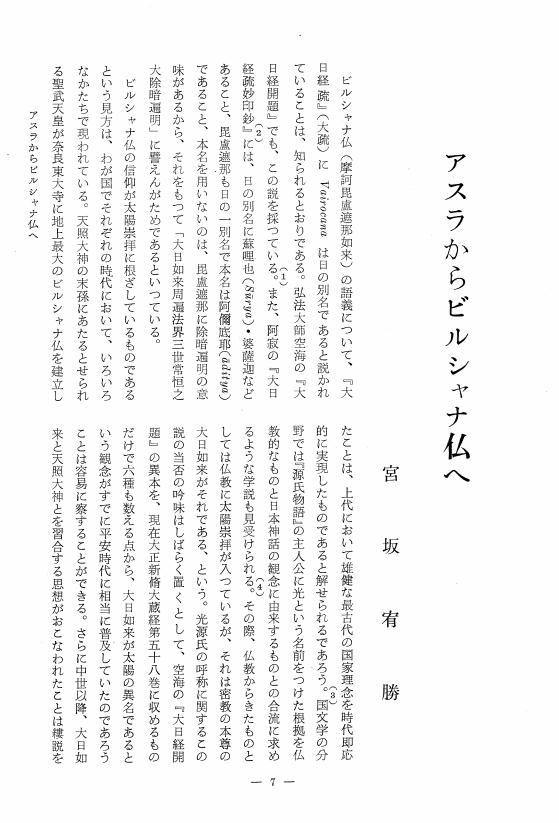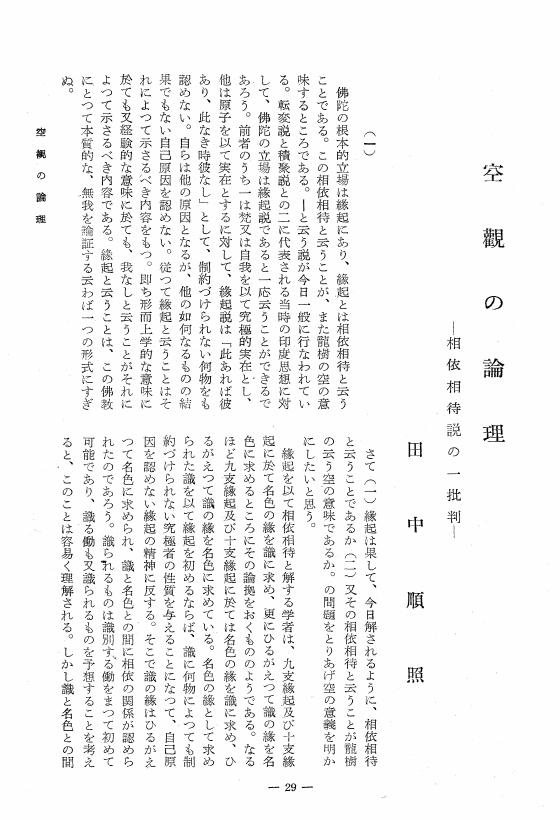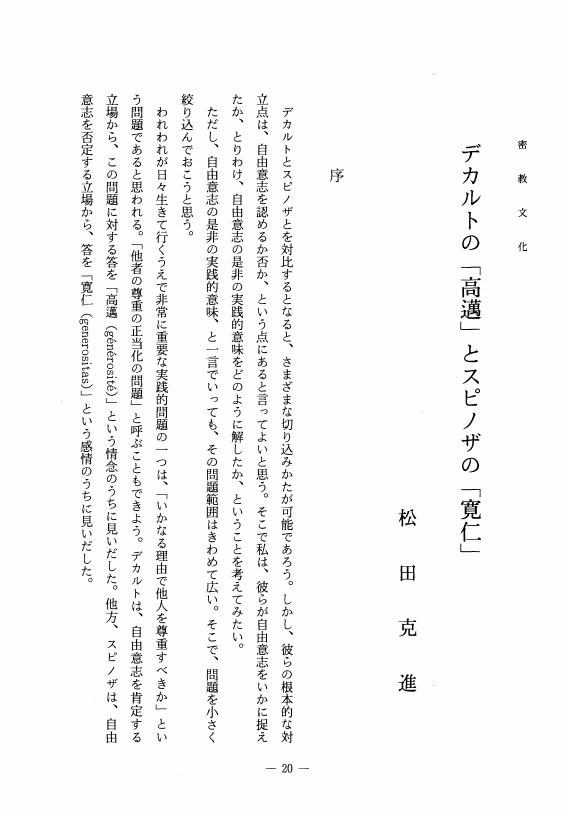4 0 0 0 プラーナ概説
- 著者
- 中野 照義 ウインテルニッツ
- 出版者
- Association of Esoteric Buddhist Studies
- 雑誌
- 密教文化 (ISSN:02869837)
- 巻号頁・発行日
- vol.1958, no.40, pp.25-72, 1958
4 0 0 0 OA 若き日の岩野泡鳴
- 著者
- 三木 正浩
- 出版者
- 密教研究会
- 雑誌
- 密教文化 (ISSN:02869837)
- 巻号頁・発行日
- vol.1960, no.48-50, pp.161-168, 1960-11-25 (Released:2010-03-12)
3 0 0 0 OA 醍醐三宝院に伝わる小冊子本『孔雀経音義』の周辺 五十音図史研究の準備のために
- 著者
- 小林 明美
- 出版者
- 密教研究会
- 雑誌
- 密教文化 (ISSN:02869837)
- 巻号頁・発行日
- vol.1983, no.144, pp.88-64, 1983-10-21 (Released:2010-03-12)
3 0 0 0 OA 荀子の性悪説について
- 著者
- 遠藤 隆芳
- 出版者
- 密教研究会
- 雑誌
- 密教文化 (ISSN:02869837)
- 巻号頁・発行日
- vol.1983, no.144, pp.23-36, 1983-10-21 (Released:2010-03-12)
3 0 0 0 OA 浄厳の密教思想
- 著者
- 上田 霊城
- 出版者
- 密教研究会
- 雑誌
- 密教文化 (ISSN:02869837)
- 巻号頁・発行日
- vol.1975, no.109, pp.23-38, 1975-01-30 (Released:2010-03-12)
3 0 0 0 OA アスラからビルシャナ仏へ
- 著者
- 宮坂 宥勝
- 出版者
- 密教研究会
- 雑誌
- 密教文化 (ISSN:02869837)
- 巻号頁・発行日
- vol.1960, no.47, pp.7-23, 1960-08-25 (Released:2010-03-12)
3 0 0 0 OA 空觀の論理 相依相待説の一批判
- 著者
- 田中 順照
- 出版者
- 密教研究会
- 雑誌
- 密教文化 (ISSN:02869837)
- 巻号頁・発行日
- vol.1953, no.23, pp.29-42, 1953-06-15 (Released:2010-03-12)
3 0 0 0 OA 麗気記の基礎的考察
- 著者
- 久保田 収
- 出版者
- 密教研究会
- 雑誌
- 密教文化 (ISSN:02869837)
- 巻号頁・発行日
- vol.1959, no.43-44, pp.49-72, 1959-08-31 (Released:2010-03-12)
3 0 0 0 OA 九世紀の日本人が聞いたサンスクリットの長母音と二重母音
- 著者
- 小林 明美
- 出版者
- 密教研究会
- 雑誌
- 密教文化 (ISSN:02869837)
- 巻号頁・発行日
- vol.1981, no.137, pp.L48-L37, 1981-02-21 (Released:2010-03-12)
3 0 0 0 中ノ川実範の生涯とその浄土教
- 著者
- 佐藤 哲英
- 出版者
- 密教研究会
- 雑誌
- 密教文化 (ISSN:02869837)
- 巻号頁・発行日
- vol.1965, no.71, pp.21-52, 1965
3 0 0 0 大槻快尊伝
- 著者
- 斎藤 昭俊
- 出版者
- Association of Esoteric Buddhist Studies
- 雑誌
- 密教文化 (ISSN:02869837)
- 巻号頁・発行日
- vol.1974, no.106, pp.48-50, 1974
3 0 0 0 OA インドアリアンの葬儀と祖霊祭
- 著者
- 中野 義照
- 出版者
- 密教研究会
- 雑誌
- 密教文化 (ISSN:02869837)
- 巻号頁・発行日
- vol.1960, no.48-50, pp.52-70, 1960-11-25 (Released:2010-03-12)
3 0 0 0 OA 文観房弘真と文殊信仰
- 著者
- 田村 隆照
- 出版者
- 密教研究会
- 雑誌
- 密教文化 (ISSN:02869837)
- 巻号頁・発行日
- vol.1966, no.76, pp.1-13, 1966-09-15 (Released:2010-03-12)
2 0 0 0 OA デカルトの「高邁」とスピノザの「寛仁」
- 著者
- 松田 克進
- 出版者
- 密教研究会
- 雑誌
- 密教文化 (ISSN:02869837)
- 巻号頁・発行日
- vol.1995, no.190, pp.20-33, 1995-02-25 (Released:2010-03-12)
2 0 0 0 OA 始皇帝に関する一考察 彼の内面的要素と大秦帝国の崩壊との関連性
- 著者
- 武生 龍真
- 出版者
- 密教研究会
- 雑誌
- 密教文化 (ISSN:02869837)
- 巻号頁・発行日
- vol.1971, no.96, pp.18-23, 1971-09-30 (Released:2010-03-12)
2 0 0 0 OA 円仁の長母音知覚
- 著者
- 小林 明美
- 出版者
- 密教研究会
- 雑誌
- 密教文化 (ISSN:02869837)
- 巻号頁・発行日
- vol.1983, no.141, pp.L86-L68, 1983-02-21 (Released:2010-03-12)
2 0 0 0 OA ヘンリー六世回顧 シェイクスピア史劇を中心に
- 著者
- 城谷 峰〓
- 出版者
- 密教研究会
- 雑誌
- 密教文化 (ISSN:02869837)
- 巻号頁・発行日
- vol.1954, no.28, pp.25-45, 1954-09-20 (Released:2010-03-16)
- 参考文献数
- 3
2 0 0 0 OA 起信論に関する一考察
- 著者
- 柏木 弘雄
- 出版者
- 密教研究会
- 雑誌
- 密教文化 (ISSN:02869837)
- 巻号頁・発行日
- vol.1961, no.52, pp.55-67, 1961-03-15 (Released:2010-03-12)
2 0 0 0 OA 護法童子
- 著者
- 和多 昭夫
- 出版者
- 密教研究会
- 雑誌
- 密教文化 (ISSN:02869837)
- 巻号頁・発行日
- vol.1973, no.104, pp.19-41, 1973-12-20 (Released:2010-03-12)
2 0 0 0 OA 写し霊場と新規霊場開設の実態について
- 著者
- 柴谷 宗叔
- 出版者
- 密教研究会
- 雑誌
- 密教文化 (ISSN:02869837)
- 巻号頁・発行日
- vol.2008, no.221, pp.73-97,127, 2008-12-21 (Released:2010-03-12)
A study of pilgrimage in Japan cannot ignore the existence of nationwide local imitations of the Saikoku Thirty-three Temples Pilgrimage route and the Shikoku Eighty-eight Temples Pilgrimage route. In the late Showa era, several new pilgrimage routes concerning Fudo or Yakushi came into existence. I discovered that the periods when pilgrimage routes in Japan came into existence can be divided into four groupings: mid- to late-Edo period, after the late 1880s or 1890s (Meiji 20s), prewar Showa era, and the late 1960s (Showa 40s) to the present. All of these correspond to periods in which the Shikoku and Saikoku pilgrimage routes were successful. After considering the several Kawachi Saikoku routes in Osaka, I summarized the sequence of events in which the pilgrimage routes of Kitakawachi and Nakagawachi re-arose independently and without communication, so that there was duplication in names. I also confirmed that during and after the Edo period there were at least five groups with more than ten kinds of pilgrimage routes in imitation of the Saikoku pilgrimage in Kawachi. After studying the circumstances of newly created pilgrimage routes that are appearing in rapid succession today, I examined the existence of two shikakenin.

